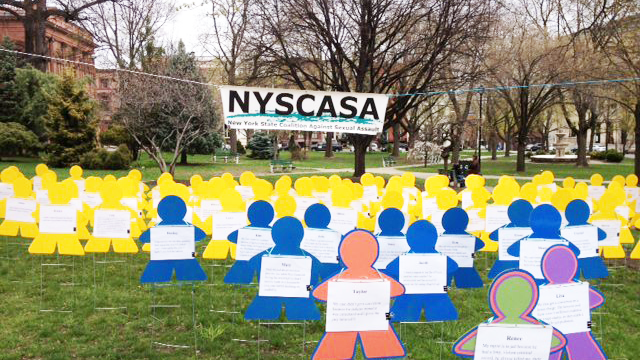This post was written by Selena Bennett-Chambers, Director of Public Policy at the New York State Coalition Against Sexual Assault as part of our PowHer the Vote 2017 campaign.
NYSCASA is dedicated to addressing and ultimately ending all forms of sexual violence. Since we realize violence doesn’t happen in a vacuum, we understand that we have to shift the culture and employ strategies at the individual level, relationship level, community level and societal level (as referred to in the socioecological model) to end violence on campus, on the street, at a workplace or anywhere else violence takes place.
That being said prevention efforts should focus on promoting healthy relationships, affirmative consent, respect for all people, and equality across the gender, racial, social, and economic spectrums. This shift will occur if prevention efforts and non-violent norms are supported and reinforced on multiple levels.
Prevention efforts should be undertaken with the goal of minimizing the risk factors for perpetration and increasing protective factors, because sexual violence will only end when there are no longer people committing sexually violent acts. Funding for this work is critical, but that it must not be at the expense of funding for victim services.
Local officials can support this work by introducing legislation that requires an assessment of the state of women and other marginalized communities and using that data to tackle the issues that are found. A commission or task force consisting of relevant stakeholders could provide recommendations and ideas to address findings. Local officials could then prioritize those issues and work towards remedying those issues through a coordinated approach. An example of this type of effort can be found here.
In addition to that, local governments can help with supporting community wide prevention efforts (Engagement of community stakeholders is integral) which seek to raise awareness about sexual violence and other forms of violence and also seek to create a culture where sexual violence, and violence as a whole, is not tolerated.
Ask your local officials and candidates:
- How are you supporting efforts to prevent or address sexual violence, domestic violence, dating violence and stalking? (Ask for specifics)
- What does cultural norm change mean to you and how are you supporting these efforts in the community?
Prevention work should be guided by principles of effective prevention programming. Because sexual violence is a complex problem, primary prevention strategies are often multi-faceted and work to address several of the six levels of the Spectrum of Prevention. First designed by Larry Cohen the spectrum of prevention includes the following six levels:
Level 1: Strengthening Individual Knowledge and Skills
Enhancing an individual’s capacity of preventing injury or illness and promoting safety
Level 2: Promoting Community Education
Reaching groups of people with information and resources to promote health and safety
Level 3: Educating Providers
Informing providers who will transmit skills and knowledge to others
Level 4: Fostering Coalitions and Networks
Bringing groups and individuals together for broader goals and greater impact
Level 5: Changing Organizational Practices
Adopting regulations and shaping norms to improve health and safety
Level 6: Influencing Policy Legislation
Developing strategies to change laws and policies to influence outcomes
Ultimately, violence is rooted in oppression and we must work to dismantle all forms of oppression. This means that racism, sexism, homophobia, transphobia, classism, ableism, nativism and other forms of discrimination must be eliminated.


